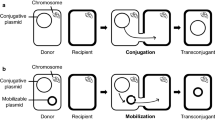Abstract
Zymomonas mobilis is being considered for the industrial production of ethyl alcohol. Expansion of its substrate range of glucose, fructose and sucrose could be advantageous, but genetic manipulation of Z. mobilis is restricted as it is resistant to transformation. We present a protocol using electroporation for high efficiency transformation of this bacterium. Optimal parameters included cooled cells (0–4° C), use of 10% glycerol as an osmotic support medium, a pulse in the 12 kV/cm range for 10 ms and outgrowth on GYx medium prior to selection. The routine efficiency achieved was greater than 1.0 × 107/μg DNA, a major increase over other transformation methods in which yields ranged from 100–2000/μg DNA.
Similar content being viewed by others
References
Boyer HW, Roulland-Dussoix D (1969) A complementation analysis of the restriction and modification of DNA in Escherichia coli. J. Mol Biol 41:459–472
Buchholz SE, Eveleigh DE (1989) Effect of dilution buffers on cell viability of Zymomonas mobilis. J. Microbiol Methods 18:65–69
Buchholz SE, Eveleigh DE (1990) Genetic modification of Z. mobilis. Biotechnol Adv 8:547–581
Calvin NM, Hanawalt PC (1988) High efficiency transformation of bacterial cells by electroporation. J Bacteriol 88:2796–2801
Chang DC, Chassy BM, Saunders JA, Sowers AE (eds) (1992) Guide to electroporation and electrofusion. Academic Press, New York
Chassy BM, Mercenier A, Flickinger J (1988) Transformation of bacteria by electroporation. Tibtech 6:303–309
Dower WJ, Miller JF, Ragdale CW (1988) High efficiency transformation of E. coli by high voltage electroporation. Nucleic Acids Res 16:6127–6144
Dower WJ, Chassy BM, Trevors JT, Blaschek HP (1992) Protocols for the transformation of bacteria by electroporation. In: Chang DC, Chassy BM, Saunders JA, Sowers AE (eds) Guide to electroporation and electrofusion. Academic Press, New York, pp 485–499
Fromm M, Taylor LP, Walbot V (1985) Expression of genes transferred into monocot and dicot plant cells by electroporation. Proc Natl Acad Sci USA 82:5824–5828
Hanahan D (1983) Techniques for transformation of E. coli. In: Glover DM (ed) DNA cloning: a practical approach, vol. 1. IRC Press, Washington, D.C., pp 109–135
Hanahan D, Jessee J, Bloom FR (1991) Plasmid transformation of Escherichia coli and other bacteria. Methods Enzymol 204:63–113
Hashimoto H, Morijawa H, Yamata Y, Kimura A (1985) A novel method for transformation of intact yeast cells by electroinjection of plasmid DNA. Appl Microbiol Biotechnol 2:336–339
Ingram LO, Eddy CK, MacKenzie KF, Conway T, Alterthun F (1989) Genetics of Zymomonas mobilis and ethanol production. Dev Ind Microbiol 30:53–69
Karube I, Tamiya E, Matsuoka H (1985) Transformation of Saccharomyces cerevisiae spheroplasts by high electric pulse. FEBS Lett 182:90–94
Lam CK (1990) An inexpensive home made pulser — transformation of bacterial, mammalian and intact yeast cells. In: Chang DC (ed) Marine Biological Laboratory, Woods Hole, Mass., USA, p 43
Lam CK (1991) Transformation through electroporation: concepts and the design of an electropulser. Ph. D. Thesis. Rutgers University, New Brunswick, N. J.
Mercenier A, Chassy BM (1988) Strategies for the development of bacterial transformation system. Biochimie 70:503–517
Montenecourt BS (1985) Zymomonas, a unique genus of bacteria. In: Demain AL, Solomon NA (eds) Biology of industrial microorganisms. Benjamin/Cummings, Menlo Park, Calif., pp 261–290
Neumann E, Rosenheck K (1972) Permeability changes induced by electric impulses in vesicular membranes. J Membrane Biol 10:270–290
Neumann E, Schaefer M, Wang Y, Hofscheider PH (1982) Gene transfer into mouse lyoma cells by electroporation in high electric fields. EMBO J 7:841–845
Ou-Lee TM, Turgeon R, Wu R (1986) Expression of a foreign gene linked to either a plant virus or a Drosophila promoter, after electroporation of protoplasts of rice, wheat, and sorghum. Proc Natl Acad Sci USA 83:6815–6819
Reynen M, Reipen I, Sahm H, Sprenger GA (1990) Construction of expression vectors for the Gram-negative bacterium Zymomonas mobilis. Mol Gen Genet 223:355–341
Rogers PL, Lee KJ, Lee JH, Skotnicki ML (1984) Recent developments in the Zymomonas process for ethanol production. CRC Crit Rev Biotechnol 1:273–288
Sambrook J, Maniatis T, Fritsch EF (1989) Molecular cloning. A laboratory manual, 2nd edn. Cold Spring Harbor Laboratory Press, Cold Spring Harbor, N.Y.
Shivarova N, Forster E, Jacob HE, Grigorova R (1983) Microbiological implications of electric field effects. VII. Stimulation of plasmids transformation of Bacillus cereus protoplast by electric field pulses. Z Allg Mikrobiol 23:595–599
Simon R, Priefer U, Puhler A (1983) A broad host range mobilization system for in vivo genetic engineering: transposon mutagenesis in Gram-negative bacteria. Bio/Technology 1:784–791
Skotnicki ML, Tribe DE, Rogers PL (1980) R-plasmid transfer in Zymomonas mobilis. Appl Environ Microbiol 40:7–12
Stokes HW, Dally EL, Yablonsky MD, Eveleigh DE (1983) Comparison of plasmids of strains of Zymomonas mobilis. Plasmid 9:138–146
Su P (1989) Genetic manipulation of Zymomonas mobilis: gene transfer system, cloning and expression of genes involved in cellulosic bioconversion. Ph. D. Thesis dissertation, University of New South Wales, Australia
Swings J, De Ley J (1977) The biology of Zymomonas. Bacteriol Rev 41:1–46
Yablonsky MD, Goodman AE, Stevnsborg N, Goncalves de Lima O, Falcao de Morais JO, Lawford HG, Rogers PL, Eveleigh DE (1988) Zymomonas mobilis CP4: a clarification of strains via plasmid profiles. J Biotechnol 9:71–80
Zimmerman U, Schulz J, Pilwat (1973) Transcellular ion flow in Escherichia coli B and electrical sizing of bacteria. Biophys J 13:1005–1013
Author information
Authors and Affiliations
Rights and permissions
About this article
Cite this article
Lam, C.K., O'Mullan, P. & Eveleigh, D.E. Transformation of Zymononas mobilis by electroporation. Appl Microbiol Biotechnol 39, 305–308 (1993). https://doi.org/10.1007/BF00192083
Received:
Accepted:
Issue Date:
DOI: https://doi.org/10.1007/BF00192083




